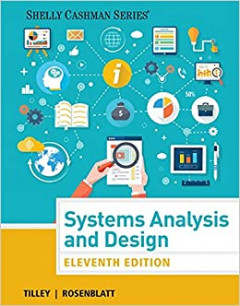Filter by

System analysis and design
Discover a practical, streamlined, updated approach to information systems development that covers both traditional and emerging technologies and approaches to systems analysis and design. SYSTEMS ANALYSIS AND DESIGN, 11E offers a well-organized, streamlined approach. Chapter objectives are keyed directly to chapter headings, making content easy to comprehend and convenient to study. Numerous r…
- Edition
- Eleventh Edition
- ISBN/ISSN
- 9781305494602
- Collation
- xx, 572 hlm; 28 cm
- Series Title
- Shelly Cashman Series
- Call Number
- 003 TIL s

Software architecture in practice
Table of contents: Part 1. Introduction 1. What is software architecture? 2. Why is software architecture important? 3. The many contexts of software architecture Part 2. Quality Attibuties 4. Understanding quality attributes 5. Availability 6. Interoperability 7. Modifiability 8. Performance …
- Edition
- Third Edition
- ISBN/ISSN
- 9780321815736
- Collation
- xix, 589 hal.; ilus.; 25 cm
- Series Title
- SEI series in software engineering
- Call Number
- 005.1 BAS s

Cyber-physical system design with sensor networking technologies
Contents: 1 Wireless sensor networks: basics and fundamentals 2 Cyber-physical systems: basics and fundamentals 3 Integrating wireless sensor networks and cyber-physical systems: challenges and opportunities 4 Enabling cyber-physical systems architectural design with wireless sensor network technologies 5 Cyber security in cyber-physical systems: on false data injection attacks in t…
- Edition
- --
- ISBN/ISSN
- 9781849198240
- Collation
- xxii, 340 hal.; ilus.; 24 cm
- Series Title
- IET control engineering series 96
- Call Number
- R004.6 ZEA c

A Practical introduction to hardware software codesign
Part I: Basic Concepts Chapter 1: The Nature of Hardware and Software Chapter 2: Data flow Modeling and transformation Chapter 3: Data flow implementation in software and hardware Chapter 4: Analysis of Control Flow and Data Flow Part II: The Design Space of Custom Architectures (Dedicated to Flexible) Chapter 5: Finite State Machine with Datapath Chapter 6: Microprogrammed Architec…
- Edition
- 2nd Edition
- ISBN/ISSN
- 9781489990600
- Collation
- xxii, 480 hal.; ilus.; 24 cm.
- Series Title
- --
- Call Number
- 003 SCH p

Principles of database design
- Edition
- -
- ISBN/ISSN
- -
- Collation
- -
- Series Title
- -
- Call Number
- 005.74 YAO p
- Edition
- -
- ISBN/ISSN
- -
- Collation
- -
- Series Title
- -
- Call Number
- 005.74 YAO p

Android hacking
null
- Edition
- Fifth Edition
- ISBN/ISSN
- 9780124077263
- Collation
- xii, 575 hlm.: ilus.; 23 cm
- Series Title
- --
- Call Number
- 004.21 PAT c

A Practical introduction to hardware software codesign
Part I: Basic Concepts Chapter 1: The Nature of Hardware and Software Chapter 2: Data flow Modeling and Implementation Chapter 3: Analysis of Control Flow and Data Flow Part II: The Design Space of Custom Architectures (Dedicated to Flexible) Chapter 4: Finite State Machine with Datapath Chapter 5: Microprogrammed Architectures Chapter 6: General-purpose Embedded Cores Chapter 7: S…
- Edition
- -
- ISBN/ISSN
- 9781441959997
- Collation
- xviii, 396 hlm.; ilus.: 24 cm
- Series Title
- -
- Call Number
- 003 SCH p
 Computer Science, Information & General Works
Computer Science, Information & General Works  Philosophy & Psychology
Philosophy & Psychology  Religion
Religion  Social Sciences
Social Sciences  Language
Language  Pure Science
Pure Science  Applied Sciences
Applied Sciences  Art & Recreation
Art & Recreation  Literature
Literature  History & Geography
History & Geography